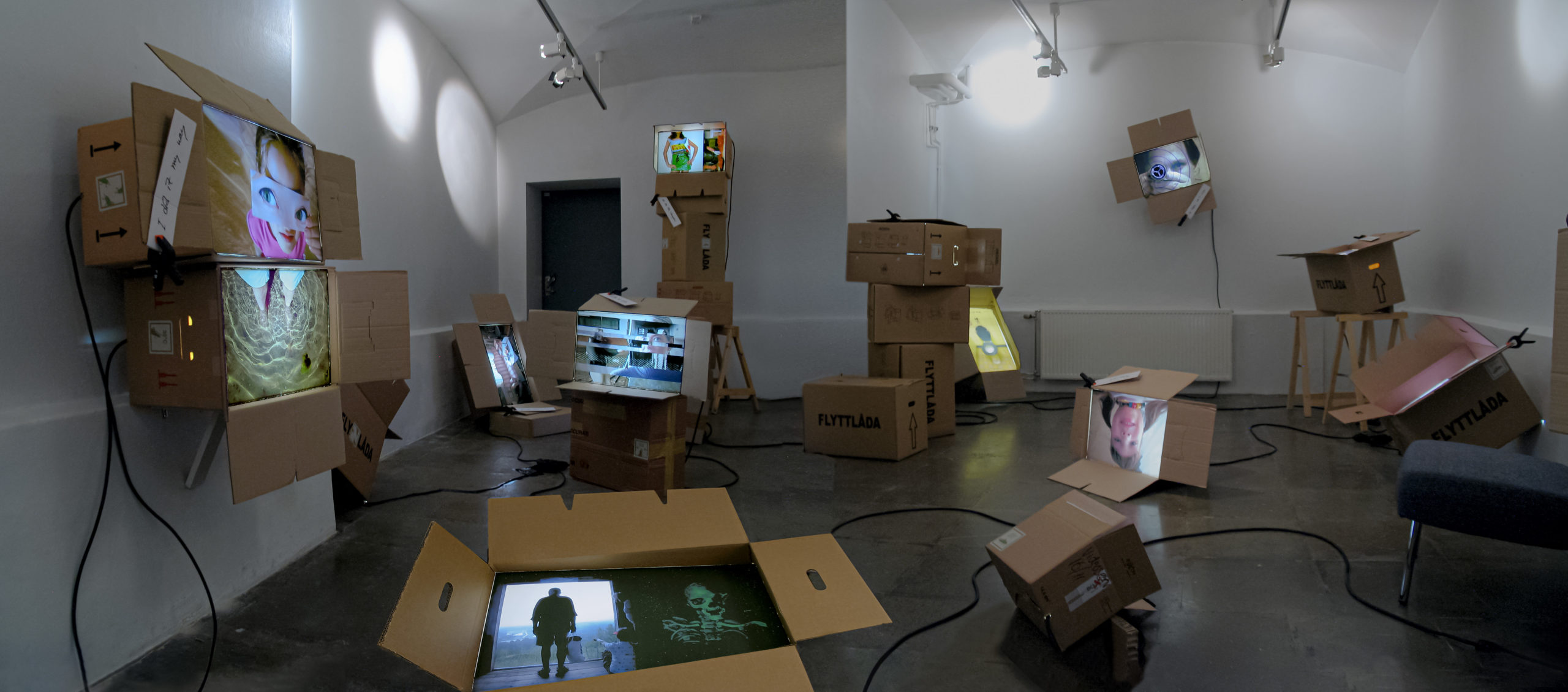

Dissolving Self
Installation
Technique: illuminated cardboard boxes & soundscapes
Size: varies due to space
An installation with storage boxes lit from the inside forms the core of the space. These boxes, each internally illuminated, create a glowing sculptural environment. Visitors can move freely between the sculptural elements, navigating through the space at their own pace. Sometimes they find themselves in subdued light, a dim and quiet atmosphere that encourages introspection; sometimes they are surrounded by near darkness, where shapes dissolve and the sense of orientation becomes more fluid. The installation creates different associations, varied and personal, reminiscent of an attic space or a basement in chaos, where someone has dug around without finding anything in particular, or just left in a hurry, as if something interrupted the search. Alternatively, it might evoke an inner image, a mental projection of a landscape with strange, almost surreal rock formations, offering a dreamlike topography to the imagination.
On every box, carefully fixed in place, is a piece of paper bearing a handwritten song title. These titles are not merely labels; they function as subtle narrative cues, gently pushing the mental images formed by viewers into an unexpected twist—just enough to alter interpretation without dictating it.
Sounds come and go in the room, moving like invisible waves through the air. Frequencies from different radio stations overlap, bleed into one another, mix to create a soft sound carpet that fills the space. This sonic background shifts over time, sometimes becoming more present, sometimes fading into the distance. Within this layered audio, some famous titles are remixed, subtly intertwined with urban noises, distant traffic, voices, mechanical rhythms—transforming the familiar into something new.
Together with the ambient sounds and the images inside the boxes, the room is saturated with associations. The idea is to create open windows—pathways—to our imagination and memories, allowing visitors to construct their own interpretations and narratives as they wander around, listen, and observe.
Dissolving Self
Installation
Technique: illuminated cardboard boxes & soundscapes
Size: varies due to space
An installation with storage boxes lit from the inside forms the core of the space. These boxes, each internally illuminated, create a glowing sculptural environment. Visitors can move freely between the sculptural elements, navigating through the space at their own pace. Sometimes they find themselves in subdued light, a dim and quiet atmosphere that encourages introspection; sometimes they are surrounded by near darkness, where shapes dissolve and the sense of orientation becomes more fluid. The installation creates different associations, varied and personal, reminiscent of an attic space or a basement in chaos, where someone has dug around without finding anything in particular, or just left in a hurry, as if something interrupted the search. Alternatively, it might evoke an inner image, a mental projection of a landscape with strange, almost surreal rock formations, offering a dreamlike topography to the imagination.
On every box, carefully fixed in place, is a piece of paper bearing a handwritten song title. These titles are not merely labels; they function as subtle narrative cues, gently pushing the mental images formed by viewers into an unexpected twist—just enough to alter interpretation without dictating it.
Sounds come and go in the room, moving like invisible waves through the air. Frequencies from different radio stations overlap, bleed into one another, mix to create a soft sound carpet that fills the space. This sonic background shifts over time, sometimes becoming more present, sometimes fading into the distance. Within this layered audio, some famous titles are remixed, subtly intertwined with urban noises, distant traffic, voices, mechanical rhythms—transforming the familiar into something new.
Together with the ambient sounds and the images inside the boxes, the room is saturated with associations. The idea is to create open windows—pathways—to our imagination and memories, allowing visitors to construct their own interpretations and narratives as they wander around, listen, and observe.














